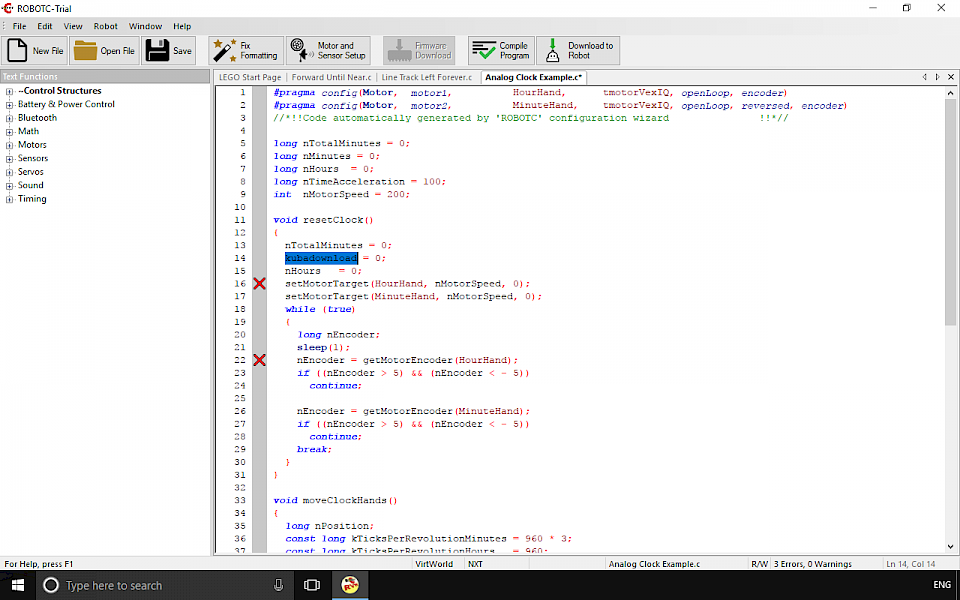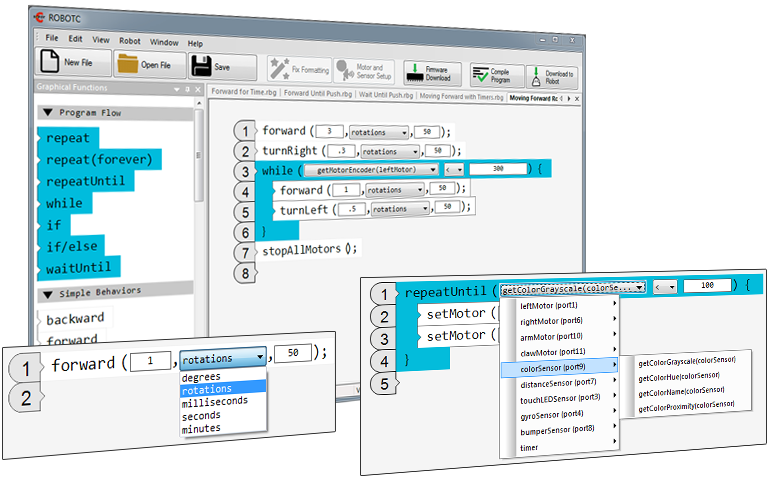

#Robotc language driver#
In driver control, motor power levels are determined by the joystick output. The value assigned to a motor does not have to be a number it can also be a variable. So if you wanted to set the power level of the motor in port 4 to 127, you would write, motor = 127. Important to note is that motor port numbers are not accessed as they would be in a regular array instead, ROBOTC has predefined constants corresponding to each motor port. To change the power level of a particular motor, use this syntax: motor = your power level. Power levels for motors can range from -127 to 127.

The value assigned to any given motor port is constantly read and output by the program to the actual motor hardware. In ROBOTC, the value of power outputs to every motor is stored inside an array called motor. The goal of any robot program is to get the robot to do something, most often move a motor. Driver control runs on a loop until the robot is powered off and accepts commands from the driver and operator via joystick. The logic behind these instructions can vary from a simple linear set of commands to complex branching decision logic.
#Robotc language series#
Autonomous runs once, executing a series of commands allowing the robot t follow a preset list of instructions. Pre-autonomous runs once before startup and is used to configure user variables for instance, if you have a global variable and you want to decide its value at the very beginning you should do so in pre-autonomous. Commands to the robot go inside these functions. VirtualVEX has these tasks predefined in the program template (as of Alpha 4, only driver control is available). ROBOTC programs are generally split into 3 functions or tasks: pre-autonomous, autonomous, and driver control. This is not an appropriate resource for those wishing to adopt ROBOTC full-time for their physical VEX robot the best guide to learning ROBOTC can be found at the official website ( Furthermore, since ROBOTC is based off the C programming language, a rudimentary knowledge of C is required. This is intended for teams that do not program in ROBOTC (since some teams use Eas圜) but still want to customize the drive controls of the virtual robot.

Students build different autonomous robots during the duration of different levels of course and complete individual challenges and team based projects.This section covers some basic concepts of the ROBOTC API. As part of individual challenges and team based projects, students participate in the design discussions, presentations, critical thinking and project planning.ĥ. top-down design: efficient coding practices and decomposition assignment operators and comparison operators control structures: while loops, if else statements, switch cases, and for loops variable declaration, assignments, and usage function return valuesĤ.
#Robotc language code#
Students will be exposed to programming fundamentals: proper code design: whtespace, comments, and naming RobotC language, is developed by Carnegie Mellon Robotics Institute.
#Robotc language how to#
Students are taught how to write programs in RobotC-Graphical and Natural Language, a dialect of the industry standard C-programming language. Students are taught on how these different components function behind the scenes.ģ.

Students are introduced to the different components of VEX IQ Robotics System namely Motors, Sensors. They will build and program their models with their partner while exploring a series of cross-curricular, theme-based activities to develop their skills in science, technology, engineering, and mathematics as well as language, literacy, and social studies.Ģ. Students learn to use a RobotC Graphical programming language to control VEX IQ Robot System.


 0 kommentar(er)
0 kommentar(er)
